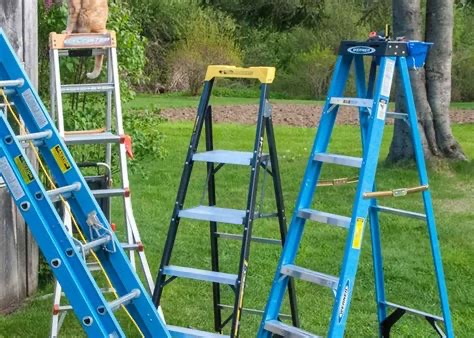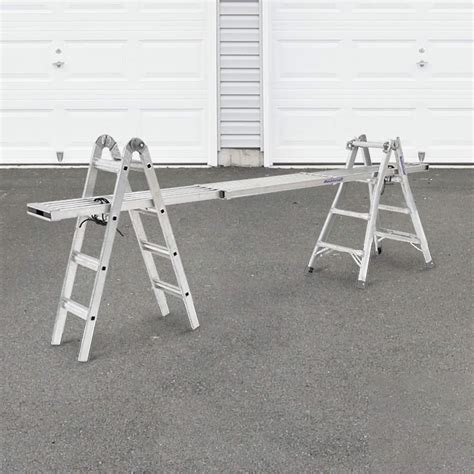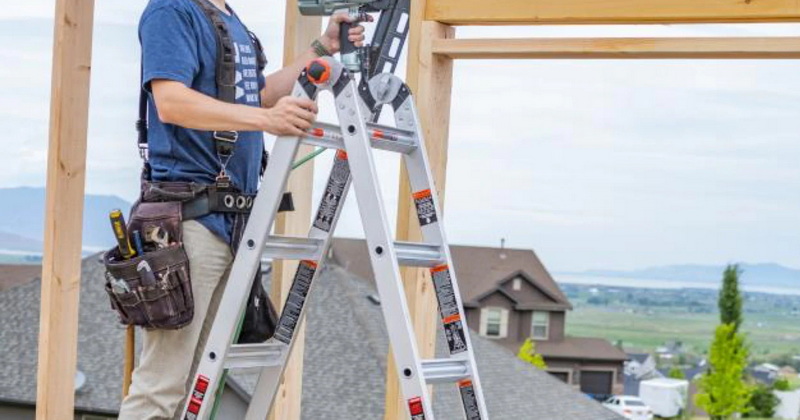Content Menu
● Introduction to Scaffolding Ladders
>> Ladders vs. Scaffolding
>> Types of Ladders
>> Types of Scaffolding
● Choosing the Right Scaffolding Ladder
>> Height and Reach
>> Safety Features
>> Weight Capacity
>> Material and Durability
>> Unique Product Solutions
● Safety Considerations
>> Securing the Ladder
>> Angle of the Ladder
>> Regular Inspection
● Using Ladders on Scaffolding
>> Access Points
>> Ladder Placement
● Types of Ladder Scaffolds
● Advanced Scaffolding Systems
>> Modular Scaffolding
>> Mobile Scaffolding
>> Specialized Scaffolding
● Training and Certification
>> Training Programs
● Regulatory Compliance
>> Compliance Checklist
● Environmental Considerations
>> Sustainable Materials
● Conclusion
● FAQ
>> 1. What is the primary difference between a ladder and scaffolding?
>> 2. How should a ladder be positioned on scaffolding?
>> 3. What safety features should I look for in a scaffolding ladder?
>> 4. How often should I inspect my scaffolding ladder?
>> 5. What are the key factors to consider when choosing a scaffolding ladder?
● Citations:
Choosing the right scaffolding ladder for your project is crucial for ensuring safety and efficiency. Whether you're working on a construction site, a renovation project, or any other task that requires working at heights, selecting the appropriate ladder can significantly impact the success and safety of your work. In this article, we will explore the key factors to consider when selecting a scaffolding ladder, discuss different types of ladders and scaffolding, and provide guidance on how to use them safely.

Introduction to Scaffolding Ladders
Scaffolding ladders are essential tools used to access different levels of scaffolding structures. They are designed to provide safe and stable access for workers to perform various tasks at heights. However, choosing the right ladder involves understanding the differences between ladders and scaffolding, as well as knowing how to use them effectively.
Ladders vs. Scaffolding
Ladders are lightweight and portable, ideal for quick, short-duration tasks at moderate heights. They are less stable and rely on user balance for safety. In contrast, scaffolding provides a stable, elevated work platform suitable for extended tasks requiring multiple workers. Scaffolds offer superior stability with a wide base and level platform, minimizing risks of tipping or imbalance.
| Aspect | Ladder | Scaffold |
| Purpose | Quick access for short tasks | Stable platform for extended tasks |
| Stability | Less stable, relies on user balance | Highly stable with a wide base |
| Platform Size | Narrow steps, supports one user | Large platform, accommodates multiple workers |
| Safety Features | Limited, may include anti-slip steps | Guardrails, toeboards, anti-slip platforms |
| Height Limitation | Suitable for moderate heights | Can reach high or multi-story levels |
| Portability | Lightweight, easy to carry | Bulkier, may need disassembly to move |
| Weight Capacity | Limited, supports one user | Higher, supports multiple workers and equipment |
Types of Ladders
1. Step Ladders: Ideal for activities requiring a smaller reach and a sturdy base.
2. Extension Ladders: Extendable and perfect for reaching higher places.
3. Platform Ladders: Have a platform at the top for additional support during long tasks.
Types of Scaffolding
1. Supported Scaffolding: Frequently used for outdoor building work, sits on hard surfaces.
2. Suspended Scaffolding: Ideal for tasks needing movement, hangs from above structures.
3. Rolling Scaffolding: Includes wheels for easy positioning or adjustability on building sites.
Choosing the Right Scaffolding Ladder
When selecting a scaffolding ladder, consider the following factors:
Height and Reach
Ensure the ladder can reach the desired height comfortably without requiring you to stretch or lean. For higher tasks, extension ladders might be more suitable.
Safety Features
Look for ladders with built-in safety features such as stabilizing arms or anti-slip steps. Always ensure the ladder is securely positioned and extends at least three feet above the working level.
Weight Capacity
Choose a ladder with a weight capacity suitable for the planned use. Overloading a ladder can compromise its structural integrity and pose a safety risk.
Material and Durability
Consider the materials used in the ladder's construction. Fiberglass ladders offer maximum safety and durability, while aluminum ladders are lightweight and strong.
Unique Product Solutions
Some ladders are designed with unique features such as adjustable legs for uneven surfaces or storage solutions for easier transportation.

Safety Considerations
Safety is paramount when using scaffolding ladders. Here are some key safety tips:
Securing the Ladder
Always secure the ladder to prevent it from shifting or falling. Use ladder stabilizers or tie-offs to ensure stability.
Angle of the Ladder
Position the ladder at an angle of about 75 to 80 degrees from the vertical to enhance stability and reduce the risk of it falling backward.
Regular Inspection
Regularly inspect the ladder and scaffolding components for damage or wear. This is crucial for maintaining a safe working environment.
Using Ladders on Scaffolding
When using ladders on scaffolding, adhere to these guidelines:
Access Points
Place ladders at designated access points on the scaffolding structure to ensure safe ascent and descent.
Ladder Placement
Maintain a safe distance between the ladder and the scaffold's working platform. A minimum of three meters is recommended to provide a secure surface for workers to grab onto when transitioning.
Types of Ladder Scaffolds
1. Single Ladder Scaffold: Simple and excellent for quick access to low-height tasks.
2. Double Scaffold with Ladder: Offers more stability and a platform for moving between ladders.
3. Cantilever Ladder Scaffold: Useful when there is an obstacle blocking direct access to the structure.
Advanced Scaffolding Systems
Modular Scaffolding
Modular scaffolding systems are highly versatile and can be customized to fit complex structures. They are ideal for large-scale projects requiring multiple levels of access.
Mobile Scaffolding
Mobile scaffolding units are equipped with wheels, allowing them to be easily moved around the site. This is particularly useful for tasks that require frequent repositioning.
Specialized Scaffolding
Specialized scaffolding includes systems designed for unique environments, such as confined spaces or areas with limited access. These systems often require specialized training to assemble and use safely.
Training and Certification
Proper training is essential for safely using scaffolding ladders. Ensure that all workers are certified and understand how to assemble, use, and disassemble scaffolding safely.
Training Programs
Look for training programs that cover topics such as:
- Scaffolding Assembly: Understanding how to correctly assemble scaffolding components.
- Safety Protocols: Familiarity with safety guidelines and emergency procedures.
- Inspection Techniques: Knowing how to inspect scaffolding for damage or wear.
Regulatory Compliance
Ensure that your scaffolding and ladder selection comply with local and national safety regulations. Familiarize yourself with standards such as OSHA guidelines in the U.S. or similar regulations in your region.
Compliance Checklist
- Material Specifications: Ensure materials meet safety standards.
- Weight Capacity: Verify that the weight capacity is suitable for the task.
- Regular Inspections: Schedule regular inspections to maintain compliance.
Environmental Considerations
When choosing scaffolding ladders, consider the environmental impact. Opt for materials that are sustainable and durable to minimize waste and reduce the need for frequent replacements.
Sustainable Materials
- Fiberglass: Offers durability and resistance to environmental factors.
- Aluminum: Lightweight and recyclable, reducing waste.
Conclusion
Choosing the right scaffolding ladder involves understanding the task requirements, considering safety features, and ensuring the ladder's stability and durability. By following these guidelines and adhering to safety protocols, you can ensure a safe and efficient working environment for your project.

FAQ
1. What is the primary difference between a ladder and scaffolding?
A ladder is used for quick access to elevated areas for short tasks, while scaffolding provides a stable platform for extended tasks requiring multiple workers.
2. How should a ladder be positioned on scaffolding?
A ladder should be placed at designated access points with an angle of about 75 to 80 degrees from the vertical and extend at least three feet above the working level.
3. What safety features should I look for in a scaffolding ladder?
Look for features like stabilizing arms, anti-slip steps, and ensure the ladder is securely positioned and extends above the working level.
4. How often should I inspect my scaffolding ladder?
Regular inspections are crucial to ensure the ladder and scaffolding components are free from damage or wear.
5. What are the key factors to consider when choosing a scaffolding ladder?
Consider factors such as height, safety features, weight capacity, material durability, and unique product solutions like adjustable legs or storage options.
Citations:
1.https://dss.net/guide-to-ladders-and-scaffolding-in-construction/
2.https://safetyeducations.com/difference-between-scaffold-and-ladder/
3.https://www.safex.us/scaffold-tech-bulletin/
4.https://www.bclts.org.uk/onewebmedia/Applied%20Chinese%20Language%20Studies%20V%EF%BC%88%E5%88%A0%E5%87%8F%E7%89%88%EF%BC%89.pdf
5.https://www.wsteps.com/guides/safety/choose-the-right-ladder-or-scaffold
6.https://rediusa.com/comparing-supported-and-suspended-scaffolding-types/
7.http://www.osha.gov/laws-regs/standardinterpretations/2003-11-17-0
8.https://www.wernerco.com/us/support/how-to-choose-a-ladder
9.https://www.badgerladder.com/buyers-guide-to-ladders-scaffolding/






















